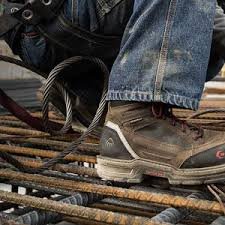Does it really matter how my safety boot is constructed?
Everyone knows the old adage “Use the right tool for the right job.” Seems easy enough. But what about when it comes to safety footwear?

Protective boots and shoes are critical to helping lay the foundation for a safer day on the jobsite. Slips, trips and falls constitute the vast majority of general industry accidents, causing 15 percent of all unintentional deaths, according to OSHA. Selecting safety footwear based on the needs, requirements and jobsite environment is key to finding the right boot to help you get through your workday without incident.The three main footwear construction methods are cement, direct attach and welted. Each delivers a series of benefits built for specific end-uses.
One of the most common things we see is workers selecting safety footwear that is not the most optimal choice for their work environment. The result? Safety footwear that falls short of performing, foot fatigue, back pain and other issues that can make the workday seem that much longer.
Looking at how a safety boot is constructed is an excellent way to start the selection process.
Cement construction offers the lightest weight of all three constructions, and is also the most flexible. Once a boot’s upper is shaped and completed, the sole is attached with an adhesive.
- Ideal environments: Environments with flat surfaces, such as assembly lines, manufacturing jobs, warehouses, and roofing and service applications, as well as jobs where the majority of time is spent standing or kneeling.
- Pros: Extremely flexible, lightweight and typically a lower price point for the wearer. This construction also offers the ability to feel the ground or work surface area beneath the foot to be surefooted with every step or movement.
- Cons: Not built for extreme environments. The cement may come apart or delaminate in caustic or abrasive work conditions, and the wearer may experience extreme foot fatigue if worn on uneven, rocky surfaces.
Direct-attach construction offers flexible comfort right from the box, as the sole is fused directly to the fibers of the uppers to produce a tough, seamless bond.
- Ideal environments: Uneven or flat work surfaces such as construction sites, manufacturing, transportation and shipping. Environments (indoor and outdoor) where standing, walking and moving is a constant.
- Pros: Offers more torsion control than a cement-style construction, helping minimize leg and foot fatigue, but is not as heavy or stiff as a welted boot. It provides extreme cushion and comfort for all-day work.
- Cons: Typically less flexible than cemented footwear and tends to be a higher price point due to the construction method.
Goodyear welt construction is the oldest, most labor-intensive construction and the most durable of the three options. It involves multiple steps to stich the insole, upper and outsole together.
- Ideal environments: Locations with rocky or uneven terrain such as railroads, building construction, land clearing, etc.; and in industries in which repeated ladder work is required. Uneven work surfaces or environments with mineral or caustic elements, such as oil and gas, agriculture, and chemical, as well as highly abrasive environments.
- Pros: This time-tested construction is the most durable, delivering better torsion control and stability on uneven and rocky work surfaces, drastically reducing fatigue in the feet, legs and lower back. The welted construction is also capable of handling more acidic, caustic or severe working environments where chemicals could potentially erode and delaminate bonded or cemented outsoles. Welted products can be resoled by a cobbler.
- Cons: Goodyear welted products are typically stiffer, heavier and offer less cushion and support, plus they tend to be the most expensive footwear option on the market.
By selecting the boot construction that best suits your work environment, you’ll find the right boot for the right job and add another tool to help you master your industry.



